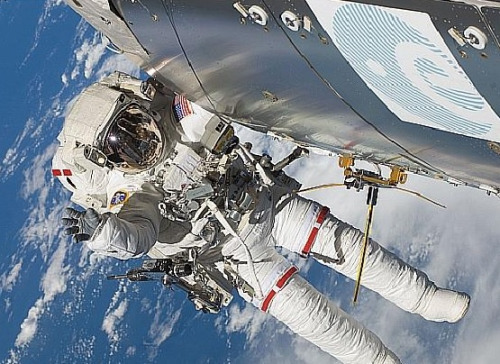
Saving
A Life From Space
People often ask, “Why do we spend
money on NASA?” And when the media provides an answer of space exploration
benefits they always start with “Velcro and computers.” Okay, that’s sort of
true, but the fact is that every single great invention has always come about
by tackling the unknown and no current organization is better at assessing and
dealing with the unknown than NASA and its contractors.
When they needed to see inside
cast aluminum structures in order to build lighter space capsules, they
invented the CAT scan, saving millions of lives a year. When they needed to
protect electronic components from the corrosive atmosphere inside capsules and
satellites they came up with electro coating circuit boards enabling all electronics
of the modern age. The technical achievement list is endless. However, I do see
growing public apathy for the need for NASA needing to be reassessed by
recognizing more human benefits. Understanding the passion of science alone is
not enough for those incapable of truly understanding why a glowing spot on
Ceres is so damn interesting.
How about saving one man’s life?
Alone in the northern Atlantic ocean for four hours, Eirikur Johannsson from
Iceland was the only living crew member after the tragic sinking of the
Hallgimur fishing ship, lost in 50 foot waves and 80 mph winds. Desperate in
freezing waters, there was virtually no hope for his survival even wearing a
thermal fisherman’s float suit. Yes, he had an emergency rescue beacon from the
Norwegian AIS satellite system, but that only gave approximate data of where a
lone man in the vastness of the ocean was struggling to stay alive.
Fortunately several years before
NASA had cooperated with international shipping countries and had designed and
now monitors a shipping vessel ID system antenna installed on the outside of
the International Space Station (ISS). Since it was installed, this ISS ship ID
system was instantaneously able to track and monitor 30,000 ships on the open
ocean. What system did it replace? None came before. Previously no one had any
idea how many ships were at sea at any given time, let alone where they were to
within twenty feet, where they were heading or, in case of an emergency, what
their last known position was (if only airplanes had this system I hear you
thinking).
Using their tracking data, NASA
was able to coordinate six rescue ships and helicopters to within feet of the
stranded sailor, way up there in the freezing north Atlantic. Four hours
Eirikur was alone, four hours and looking at a grizzly death as hypothermia set
in and unconsciousness was mere hours away and then the NASA and EIS guided
helicopter showed up. The first thing he did once aboard the helicopter was to
guide them on the search for 3 other lost crew members who were, sadly, not found.
Every
day, around the world, ships at sea now rely on this tracking data.
International shipping can be dangerous (pirates, rough seas, collisions,
navigation errors) and often knowing where a ship is allows the shipping
companies to better advise their captains on changing course, on severe weather
predictions and on political changes at destinations. Cruise ships rely heavily
on this precise data – data that was never available before to any captain at
sea, owner at home, or rescue teams. NASA to the rescue!
 newest »
newest »
 newest »
newest »
 newest »
newest »
Nancy wrote: "What a shame the human race hasn't evolved past war. Think how much money could be spent on space exploration if no country needed a defence budget and they gave it to NASA instead."